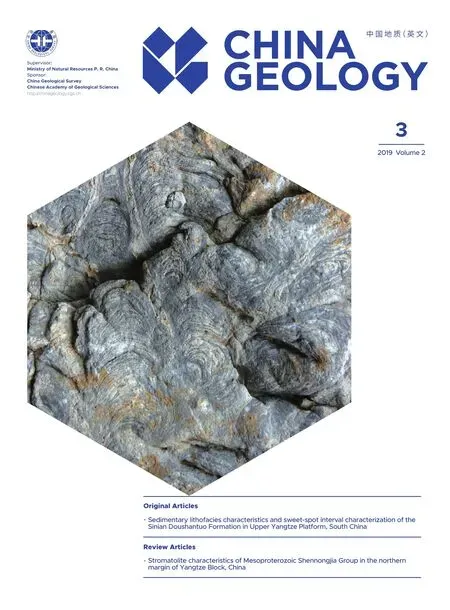Zircon U-Pb ages of the two-periods magmatism from the Xiuwacu Mo-W-Cu deposit,northwest Yunnan, China
Yong-gao Huang, Chang-li Xiong, Xiao-chuan Jia, Xue-jun Yang, Gai Luo
a Guilin University of Technology, Guilin 541004, China
b Sichuan Geological Survey, Chengdu 610081, China
c Evaluation and Utilization of Strategic Rare Metals and Rare Earth Resource Key Laboratory of Sichuan Province, Chengdu 610081, China
1.Objective
The Xiuwacu deposit is a large magmatic hydrothermal Mo-W-Cu deposit, and also a typical representative of the late Triassic mineralization in Geza Arc (Lai AQ et al., 2016; Liu XL et al., 2017).The Xiuwacu pluton intruded into the Lamaya Formation, and contains two periods of rocks bounded by intrusive contact.Nonetheless, most of the intrusive boundaries were superposed by later fault structures.The early period of intrusions is monzonitic granite and granodiorite, whereas the late period is monzonitic granite and syenogranite.In addition, aplite passed through the above two periods of intrusions (Fig.1a).The distribution of the two periods of intrusions was finished by 1:50000 regional geological mapping in Geza area.However, the exact crystallization time was not clear.In this work, new ages related to the two-periods magmatism were obtained by using LA-ICP-MS zircon U-Pb dating method, which benefits the understanding of diagenesis in the Xiuwacu Mo-W-Cu deposit.

Fig.1.Simplified geological map of the Xiuwacu intrusions (a), U-Pb concordia diagrams and representative CL images of zircons for coarsegrained monzonitic granite (b) and porphyritic-like monzonitic granite (c) form the Xiuwacu intrusions, respectively.
2.Methods
A coarse-grained monzonitic granite and porphyritic-like monzonitic granite were collected from the Xiuwacu area and were chosen to analyze.Zircon separation and cathodoluminescence (CL) images were finished by Chengxin Geological Services Co., Ltd., Langfang, China.Zircon U-Pb dating was determined at the State Key Laboratory of Continental Dynamics, Northwest University.
3.Results
The coarse-grained monzonitic granite consists of plagioclase (45%-50%), alkaline feldspar (25%-30%), quartz(20%-25%) and biotite (5%).While, the porphyritic-like monzonitic granite consists of phenoryst (20%-25%) and matrix.Zircon U-Pb isotopic data are shown in Table 1.CL images reveal that zircons from the coarse-grained monzonitic granite and porphyritic-like monzonitic granite are typically 100-250 μm in size, with length/width ratios of 1.5-4.0.All zircons show regular oscillatory magmatic zoning and have variable Th, U and Th/U ratios (0.13-1.69).Besides, there is a good positive correlation between the contents of Th and U in those zircons, implying magmatic origin.

Table 1.Zircon LA-ICPMS U-Pb data of Xiuwacu intrusions, NW Yunnan, China.
The206Pb/238U ages of fifteen zircon grains from coarsegrained monzonitic granite (XWC1) range from 213.3 Ma to 217.0 Ma, yielding a weighted mean206Pb/238U age of 215.2±2.2 Ma (MSWD=0.05, Fig.1b).The206Pb/238U ages of nine zircon grains from porphyritic-like monzonitic granite(XWC2) range from 88.4 Ma to 91.0 Ma, and the weighted mean age is 90.3±1.1 Ma (MSWD=0.3, Fig.1c).
4.Conclusion
Two-periods magmatism have been distinguished in the Xiuwacu Mo-W-Cu Deposit that the earlier period is Late Indosinian (215.2±2.2 Ma) and the later period is Late Yanshannian (90.3±1.1 Ma).
Acknowledgement
This research was financially supported by the China Geological Survey (DD20160016).
- China Geology的其它文章
- A mine drainage treatment system for AMD in remediation of metal sulfide mines
- Stromatolite characteristics of Mesoproterozoic Shennongjia Group in the northern margin of Yangtze Block, China
- Regional gravity survey and application in oil and gas exploration in China
- New zircon U-Pb ages of the Xinghuadukou Group, Xing’an block and its geological implications
- Promoting high-level cooperation in geosciences and assisting high-quality development of mining: “Belt and Road” Forum for International Geoscience Cooperation and Mining Investment was held in Xi’an, China
- Deepest deep-hole integrated geophysical observation system has successfully installed

